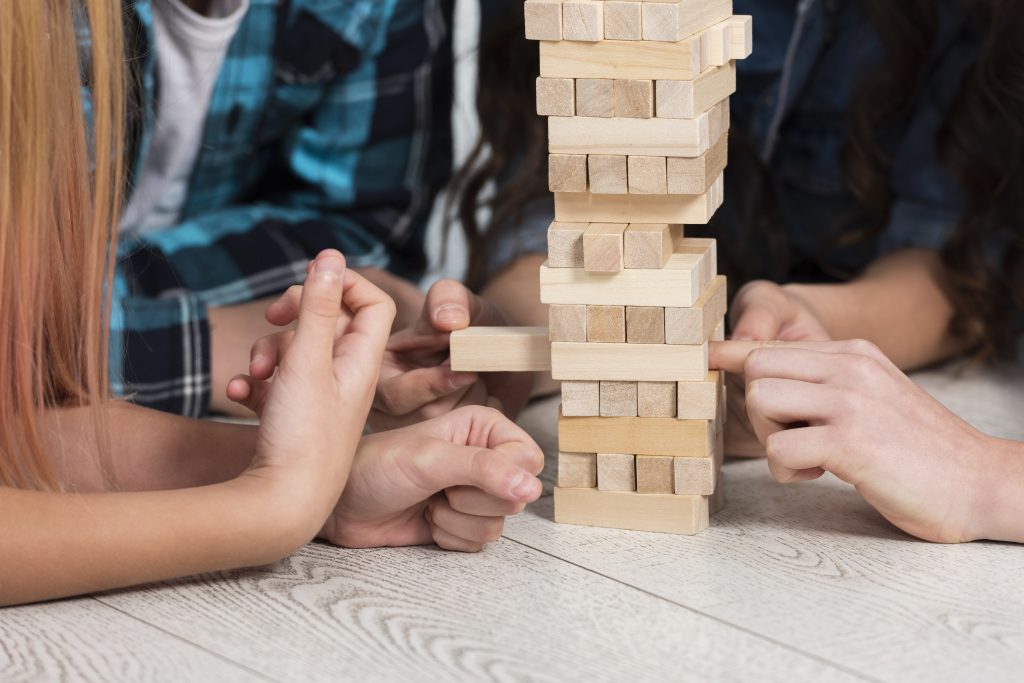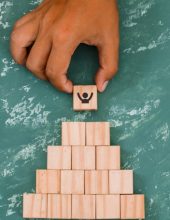A retrospective is a meeting where the team analyzes the last sprint and plans how to improve quality and efficiency. It is a critical element of the Scrum framework. Conducting retrospectives that engage all participants can be challenging, but many practices help achieve this goal.
If you’re looking for ways to make retrospectives deeper and better organized, I recommend this article (PL): Model fazowy – jak usystematyzować retrospektywę.
In it, I focus on ways to overcome the difficulties and challenges of organizing retrospectives (in the office and remotely) and make these scrum events more interesting.
What difficulties can be encountered in conducting retrospectives?
- Monotony and lack of engagement – sometimes retrospectives become routine, and participants lose interest. It is worth introducing variety to keep participants focused and engaged.
- Inappropriate atmosphere and lack of openness—Some team members may be reluctant to share their observations. Creating an atmosphere and a safe environment where team members can express their opinions, thoughts, and feelings is essential.
- Remote retrospectives – remote work can hinder active participation. Techniques must be adapted to this environment.
- Too long retrospectives – the meeting should be focused and efficient. Protracted retrospectives can lead to a loss of attention and engagement. It’s good to keep the discussion focused on relevant topics. The most important issues first, so that no one feels their time was wasted on discussions that contribute nothing.
- No action after the retrospective – identifying problems is only the first step. Taking concrete actions after the retrospective and monitoring their implementation is important. It is also important to be open to proposed changes.
In conclusion, the key to successful retrospectives is diversity, open communication, and meaningful action after the meeting.
Remotely or in the office?
One of the basic things that will define how we can organize a retro is where this meeting will take place. Do we have a team that works remotely and organizes the retro that way? Can the entire team meet in the office?
We won’t always be free to choose. A remote retrospective may be more difficult, but organizing an exciting and engaging retrospective for both approaches is possible.
Warm-up
It is also important to mention the team’s warm-up and intro, which are elements often underestimated and overlooked, even though they are important to the conduct of the entire meeting.
The warm-up before the retrospective is an extremely important part of the opening of this meeting. It is vital in creating a comfortable and safe environment for the entire team. The warm-up lets you discover the participants’ feelings, which is crucial for further effective work. Such an element also helps to introduce an atmosphere of joint action, strengthens the sense of unity, and focuses the participants’ attention on the meeting. It is conducted before the central part of the retrospective to fully prepare the team for a fruitful discussion.
Examples of warm-ups can be varied; here are some of them:
- Build something together, such as a tower of blocks or a paper bridge. Such an activity not only integrates but also develops creativity and cooperation.
- How do you feel today? This simple question lets you get a quick idea of the participants’ moods, which can help adjust the meeting’s course to their needs and expectations.
Retro as a board game
Preparing a retrospective in the form of an engaging board game is a great way to spice up this important event and engage the team. This approach allows participants to participate more actively, leading to more fruitful discussions and better results.
Before you begin preparations, clearly define the purpose of the retrospective. Do you want to focus on identifying problems, improving communication, enhancing cooperation, or perhaps innovative solutions? The goal will help you choose the right game mechanics. Carefully think through what you want to achieve and the specific objectives.
Introducing a storyline can significantly increase team engagement. It could be a journey through unknown lands in search of treasure (solutions), a rescue mission on an alien planet (fixing problems), or building a city (improving processes). The plot should be interesting enough to capture the participants’ attention and encourage active participation.
Game mechanics
- Movement – determine how players will move around the board. This can be by rolling dice, drawing cards, or reaching small targets. The mechanics should be simple but engaging to keep the game pace.
- Challenge cards – on some fields, players can draw challenge cards that will contain retrospective questions, such as “What went well in the last sprint?” or “What can we improve on in the next sprint?”. Challenge cards can also contain tasks to be completed to stimulate the team’s creativity.
- Reward cards – for providing constructive answers or solving problems, players can receive rewards that can be used in the game (e.g., extra movement, jumping the field). Rewards can also motivate participants to participate more actively.
Preparing and conducting the game
- Introduction – before starting the game, introduce the team to the rules and plot. Explain why this form of retrospective was chosen. Providing context and purpose is key to engaging all participants.
- Course of the game – conduct the game according to the established rules, trying to involve all participants. Encourage open discussion and sharing of ideas. Monitor the progress of the game and intervene if any problems arise.
Remember that such a retrospective is also easy to prepare online. Here are some examples of this, such as using available tools for virtual meetings and collaborations, such as Miro, Trello, or Zoom. Ready-made templates make the process easier.
Retro – Lego
Preparing a Scrum retrospective using Lego bricks can be effective and engaging for the team. It is an exciting form that stimulates creativity and cooperation.
Preparation of materials
- Lego – prepare a set of Legos sufficient for the whole team. Various blocks (colors, shapes, sizes) are crucial so participants can freely express their ideas and feelings. Having larger and smaller pieces to build more complex models is a good idea.
- Table or work surface – make sure there is enough space so that each team member can access the blocks and build freely. It is also a good idea to provide comfortable chairs so participants can focus on their work.
- Flipchart/Tablet – useful for jotting down conclusions and actions resulting from the retrospective. You can also use markers in different colors to visually separate the various areas of discussion.
Introductory exercise (Icebreaker)
Character building – ask each participant to build a miniature character representing himself. This will help break the ice and get participants in a creative mood. You can also ask them to briefly introduce their character, further lightening the atmosphere.
The main part of the retrospective
- Building a sprint story – ask the team to collectively build a model representing the last sprint. This can include various elements such as tasks, obstacles, successes, etc. Each participant adds blocks representing specific events or elements of the sprint. This is a great way to visualize the team’s work and understand how the individual elements affect the whole. Example: The sprint was very eventful, full of ups and downs. Ask the team to model telling the story of this sprint chronologically.
- Discussion – each participant talks about his or her part of the model, explaining what it represents. Encourage the sharing of insights and reflections on the parts being built. You can also ask questions to better understand each team member’s perspective.
- Identify areas for improvement – after building the entire model, discuss which parts of the model represent areas for improvement. You can use different colored blocks to distinguish these areas. It’s also a good idea to ask for suggestions on improving these areas.
- Creative solutions – ask the team to use the Lego bricks to build suggestions for solutions to the identified problems. Each participant or group can build a model showing how processes can improve or solve specific problems. This is not only a way to find solutions but also to strengthen team bonds.
Using Lego bricks for retrospectives can create a more engaging and creative environment, leading to deeper conclusions and better solutions. This form of work improves communication within the team and helps build a better understanding of the processes and problems the team faces.
Retro – Jenga
The game of Jenga can also be an interesting tool for conducting a team retrospective. It is an unusual but engaging way to analyze team activities and improve work processes. By combining play with reflection, participants can more easily open up to dialogue and the exchange of opinions.

Prepare Jenga blocks
- Gather a set of Jenga blocks, ensuring you have enough for all participants.
- On each block, write a question or topic related to the retrospective. You can use ready-made questions or create your own, tailored to your team’s specifics.
- Sample questions can relate to different aspects of the team, such as communication, cooperation, goal achievement, and time management. Sample questions:
- What went well in the previous period? What successes can we celebrate?
- What could we improve? What elements of our work need attention?
- What were our biggest challenges? How did we deal with them?
- What is worth keeping or changing in our work process? What practices have been effective, and which should be modified?
Running the retrospective
- Gather the team and explain that the retrospective will be based on a game of Jenga, which can introduce an element of fun and reduce tension.
- Arrange the blocks on the table so each participant can access them easily.
- Each participant pulls out one block. The questions must not be known beforehand, which adds an element of surprise.
- Players take turns to select questions from the blocks and answer them.
- After answering, the block is put back on top of the tower.
Discussion
- After the game, discuss the answers to the questions. It’s a good idea to spend enough time on this so everyone can comment on the issues raised.
- Look for common themes, trends, and conclusions that may point to major areas for improvement or development.
- Use these observations to plan actions for the future. Make a list of specific steps you can take to improve your team’s effectiveness.
Remember that the game of Jenga in a retrospective is designed to create a relaxed, friendly atmosphere where everyone can openly express their opinions. This format can help build trust within the team and better understand each other’s needs and expectations.
Solving a riddle
Choose a topic of riddles that will be appropriate for the retrospective; preferably, they should be related to the team’s work, challenges they have encountered, or successes they have achieved. The riddles will be even more interesting if you present them as an Escape Room online or in the office.
Preparation of riddles
Create several riddles, the solution of which will require the cooperation of the whole team. The riddles can be related to different aspects of the sprint, such as:
- Communication – riddles that require excellent communication and information sharing among team members. These can be tasks where success depends on clear communication and cooperation.
- Problem-solving – logical or mathematical riddles that require analytical thinking and a creative approach to a problem. These can be riddles that force the team to work through complex issues.
- Reflection – tasks that force you to reflect on what went well and what can be improved. These can be retrospective questions that make you analyze past events and draw conclusions for the future.
Structure of the game
Decide how the game will proceed. You can create a storyline that leads the team through different game stages, where each riddle leads to the next. For example, the team can explore successive rooms by solving riddles in each room to reach the final “exit.” The game’s structure should be well thought out to keep the team interested and engaged at each stage.
Preparation of materials
Organize all the materials needed for the game. These may include:
- Riddle cards – physical cards or PDF files with descriptions of the riddles. The cards can contain instructions, clues, and tasks that the team must solve. Example riddles:
- Encrypted message – prepare an encrypted message that contains a key lesson from the sprint. The team must use various clues to read the message. The clues can be hidden in task descriptions from Jira, notes from stand-ups, or even in the source code.
- Association game – choose a random word or concept related to the team’s work. Each participant must list associations related to that word. This allows for the discovery of different perspectives and helps in retrospective analysis. The association game can be a prelude to deeper discussions about the sprint and the team’s work.
- Logic riddle or puzzle – prepare a logic riddle or puzzle that the team will have to solve together. This can be, for example, a puzzle, a rebus, or even a classic math riddle. During the retrospective, the team is presented with the riddle and works together to solve it. This not only develops thinking skills but also integrates the team. These types of riddles can also be a great way to relieve tension and build a positive atmosphere.
- Props – if the game takes place physically, prepare props that will be needed to solve the riddles. These can include keys, maps, puzzles, and other items that will add realism and variety to the game.
- Online tools – if the game takes place remotely, prepare online collaboration tools, such as virtual whiteboards (e.g., Miro, Mural), video conferencing tools (e.g., Zoom), and possibly dedicated online Escape Room apps. These tools will enable effective remote communication and collaboration.
Instructions and rules
At the beginning of the retrospective, introduce the game’s rules and explain how it will be played. Assure that the goal is both to have fun and to reflect on the sprint. Rules may include:
- The team must solve each riddle as a whole. Collaboration is key, and each team member should be able to contribute.
- The timeto solve each riddle is limited to maintain the game’s momentum. The time limit adds an element of challenge and motivates the team to move faster.
- Hints may be available, but their use may result in loss of points, for example. Hints can help with more difficult riddles, but their use should be thoughtful.
Running the game
Guide the team through the game, monitoring progress and providing hints as needed. It is important to be flexible and ready to adapt to the game if the team encounters puzzles that are too difficult or need extra motivation. The flow of the game should be smooth, and any difficulties should be resolved on the fly so that the team can get the maximum benefit from the activity.
Field game
To go beyond the scheme, you can prepare a retrospective in the form of a field game. If all members of the team have the opportunity to meet in the office, this can be a really attractive diversification of the meeting. Here are some ideas for such a retrospective:
- Treasure hunt in the office – prepare a list of “treasures” (i.e., topics to discuss) related to the last sprint. A map of the office is then given to the team, which must find the “treasures” around the office and talk about each one. This allows for active movement while engaging the team in reflection.
- Task race – create a list of tasks or questions related to the team’s work. Tasks can be about communication, code quality, or work efficiency. A map of the office area is then given to the team, and they have to visit different points to solve the tasks. This allows the team to integrate and reflect on the challenges.
- Detective game – prepare a fictional story related to a recent sprint. The team is given a series of clues that lead to solving the “mystery.” During the search, the team can discuss various aspects of the sprint and lessons learned for the future.
- Outdoor riddles – if the office has access to an outdoor environment, riddles or questions can be prepared and given to the team during the walk. This allows for a change of environment and a more relaxed atmosphere.
- Playing “hot and cold” – choose an area in the office or neighborhood that symbolizes the quality of the team’s work. The team is instructed to move closer or further away from this area depending on the quality of the aspects discussed. This is an interactive form of reflection.
Remember to adapt the chosen form of the game to the nature of the team and available resources.
Planning and preparation
- Defining the goal – decide what you want to achieve during this retrospective. It could be analyzing the last sprint, identifying areas for improvement, or enhancing team collaboration.
- Game theme – choose a game theme that will be interesting and engaging for the team. It can be something related to the project, such as “agility treasure hunt,” or a more general theme, such as “jungle adventure.”
- Map and scenario – create a map of the office or neighborhood on which you mark key points to visit. Prepare a scenario for the game in which you describe the tasks and puzzles the team will have to solve.
- Supporting materials – prepare all the necessary props, such as clues, puzzles, flashback question cards, and possible prizes.
Running the game
- Kick-off meeting – gather the whole team and explain the game’s rules. Introduce the purpose of the game and safety rules. If necessary, divide the team into smaller groups.
- Checkpoints – place checkpoints in different areas of the office or neighborhood where participants will have to complete retrospective tasks. Each point should include a task that will encourage reflection on the sprint, such as:
- Reflection – at this point, write down three things that went well in the last sprint.
- Improvements – identify two areas that need improvement.Experiments – suggest one experiment that can be implemented in the next sprint.
- Puzzles and Tasks – to get to the next sprint, participants must solve puzzles or perform tasks related to teamwork and agility, e.g., The importance of teamwork and agility:
- Solving logic puzzles.
- Putting together puzzles that represent Agile values.
- Conducting a mini simulation game (e.g. Marshmallow Challenge).
Attention to detail
- Safety – make sure all tasks are safe and do not put participants at risk.
- Integration – try to make the game promote team integration and be a positive experience.
- Adaptability – be flexible and ready to make changes to the game scenario if necessary.
With such preparation, a retrospective in the form of a field game will become not only an interesting diversion but also an effective tool for reflection and team improvement.
Tasks for cooperation
Tasks for cooperation can help integrate the team and improve communication between its members. Through joint activities, employees can better understand each other’s strengths and weaknesses and learn to work together effectively in different situations. Such tasks foster trust and mutual respect, which translates into a better working atmosphere and greater team efficiency. They are also great as Warm-up elements before the main retro task.
What tasks can be used during a retrospective at the office:
- Building bridges from noodles and tape
- Divide the team into smaller groups and give them the task of building a bridge out of noodles and tape that will hold a certain weight. Additional challenges, such as limited time or special construction requirements, can be added.
- Goal – stimulate creative thinking and cooperation and strengthen bonds through joint action. This activity also helps develop problem-solving skills and test different concepts.
- Confidence spider web
- In the room, create a web of yarn or string that the team must walk through without touching the thread. Each team member must pass through a different “mesh.” You can additionally introduce elements that make the passage difficult, such as closed eyes.
- Goal – trust, coordination, and joint strategy planning. This task also teaches the importance of mutual support and communication within the team.
- Tower construction
- Give the team materials such as newspapers, sticky tape, and scissors. The task is to build the tallest tower possible in a certain amount of time. You can introduce additional criteria, such as stability of the structure or aesthetics.
- Goal – strengthen planning, coordination, and cooperation skills. This task also helps develop organizational skills and creativity.
- Drawing shapes
- Each team member draws a shape that must be recognized by others. Elements can be added, such as drawing with eyes closed or using only certain tools.
- Goal – to practice precision, communication, and visual interpretation.
Online retrospective
What tasks can be used during an online retrospective:
- Virtual taboo
- The game involves describing words without using specific forbidden words (taboos). Players work in pairs or small groups, trying to guess as many words as possible in a certain amount of time. Elements of competition between groups can be added.
- Goal – to develop communication skills, creative thinking, and teamwork.
- Puns
- One team member draws a picture on a virtual whiteboard (e.g., in Zoom or Miro), and the rest of the team tries to guess what the drawing represents. You can add thematic categories to add variety to the game.
- Goal – strengthen visualization, interpretation, and quick thinking skills. This game also fosters team integration by playing together.
- Quiz
- Prepare a quiz about the team, project, or general knowledge that the team solves together. This can also be a great way to remind the team of important facts or rules. Additionally, you can introduce prizes for the best results.
- Goal – to consolidate knowledge, integrate the team, and introduce an element of fun into the daily routine.
- Idea chains
- Each team member writes down one idea or problem on a virtual board (e.g., Miro). Other members then add their suggestions or solutions to the ideas of others, creating a “chain” of shared thoughts. You can additionally discuss individual suggestions during the meeting.
- Goal – to stimulate creative thinking collaborative problem-solving, and strengthen team cooperation.
- Stories
- Using virtual story cubes (you can find apps or websites), each team member rolls the dice and creates another part of the story based on the pictures. The story can be created based on a past sprint or other shared experience.
- Goal – to develop creativity, narrative skills, and team collaboration. This activity also fosters integration and relationship building.
- Short skits
- Divide the team into small groups and give them the task of preparing a short, humorous skit about life in the office or some situation related to the project. You can record the skits and watch them together later.
- Goal – strengthen creativity, acting skills, and teamwork. This game also helps to relieve tension and integrate the team by laughing together.
Discuss the conclusions – retro summary
At the end of the game, make a summary. Analyze exactly what was discussed during the retrospective, what conclusions were drawn, and what steps can be taken for the future. The summary should be constructive, lead to concrete actions, and inspire the whole team to continue working.
You can also ask the team about their impressions of this form of retrospective to find out what they found most valuable and what could be changed for the future.
- How did the team cooperate in solving the puzzles? Was communication effective, and did all team members have an equal opportunity to participate? What strategies proved most effective and why?
- What were the main challenges, and how were they overcome? Did the team encounter difficulties that required special approaches or innovative solutions? What lessons can be drawn from these experiences to prevent similar problems in the future?
- What lessons can be drawn from this activity and applied to the team’s daily work? Did the team discover new ways of working that could be useful in the future, such as new communication, planning, or problem-solving techniques?
- What went well, and what could be improved in the future? What elements of the game were most engaging and effective, and which could be optimized? Are there any specific areas that need more attention or a change in strategy?
Remember that the main purpose of the debriefing is not only to evaluate past activities but also to create a plan for the future that will help the team improve. It is important that every team member has the opportunity to express his or her opinions and suggestions.
Conclusion
Preparing such online games and activities requires a little more planning and commitment but can have excellent team-building results. Joint problem-solving, creative challenges, and humorous tasks can greatly strengthen bonds and improve team cooperation, even remotely.
Organizing such activities allows participants to get to know each other better, develop communication skills, and build trust, which is crucial for effective team performance. Moreover, regularly introducing such initiatives can make remote work more engaging and enjoyable for all team members.
***
If you’re interested in Agile, be sure to take a look at our other articles as well.
















Leave a comment